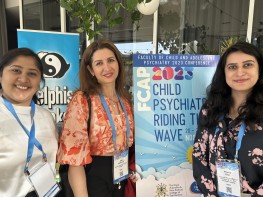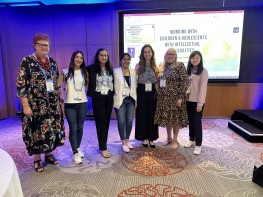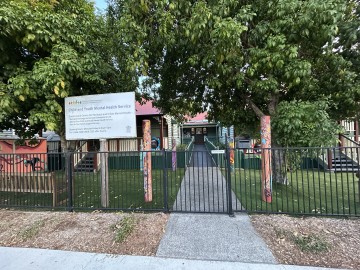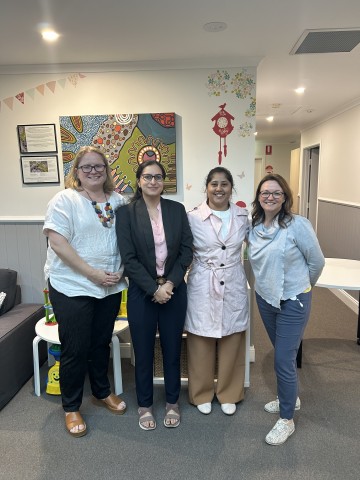Howard Cooper Travelling Fellowship in Child and Adolescent Psychiatry – An Enriching Experience
By: Dr Vinyas Nisarga1, Dr Prerna Khar2 *
1- Assistant Professor
2- Consultant Psychiatrist
Department of Psychiatry, Early Intervention and Rehabilitation Centre for Children, TNMC and BYL Nair Charitable Hospital, Mumbai, India
Child and adolescent Psychiatry (CAP), as we all know, is still an upcoming and niche branch of Psychiatry in many developing countries. Though children constitute a major segment of the population worldwide, specialized care to cater to their needs is not yet available in all parts of the world, especially in developing countries such as India.
The COVID 19 pandemic underscored the above fact by bringing a plethora of emotional and behavioral concerns in children and many of them are still grappling with its after effects. We were pursuing our post-doctoral fellowship in child and adolescent mental health (CAMH) at TNMC and BYL Nair Charitable Hospital when the COVID19 pandemic struck, forcing us to move to virtual means of education and telehealth, as our centre was declared a dedicated COVID hospital. We had applied for the Howard Cooper Travelling Fellowship (HCTF) in CAP while we were pursuing our fellowship and were lucky to be awarded the same in 2021. The HCTF is awarded by the Royal Australian and New Zealand College of Psychiatrists (RANZCP), Faculty of Child and Adolescent Psychiatry, that honours the life of Dr Howard Cooper, a child and adolescent psychiatrist. It enables a trainee psychiatrist or a psychiatrist from the Asia-Pacific region to gain experience in Child and Adolescent Psychiatry in Australia and New Zealand. Being the first from our country to win this award, added to our delight. Unfortunately, due to the ongoing pandemic and border closures, we were unable to undertake the same in 2021, though the association was continuously in touch with us for the next 2 years.
After a long wait of 2 years, we had the opportunity to visit Australia in August 2023 and it was indeed worth the wait. The fellowship was clubbed with the Faculty of Child and Adolescent Psychiatry conference at Noosa, followed by one week of clinical observership at Brisbane at Children’s Health Queensland (CHQ) Hospital and Health services. We began the conference with a pre-conference workshop on ‘Adapting Cognitive Behaviour Therapy for children and adolescents with intellectual disabilities. The three-hour long session kept us engaged, as we learned many practical tips and techniques, especially in the cognitive domain where we often encounter difficulties while addressing children with intellectual difficulties. The conference in whole was an academic feast, with a wonderful opportunity to interact with colleagues who shared the same passion as us. Our next 3 days were occupied with attending conference sessions which were mainly on the topics, comprising of developing systems to bridge treatment gaps in CAMH services, experience and learnings from different centres providing specialized care and discussing various treatment approaches and care models for varied mental health needs of children and adolescents.

CAP conference at NOOSA

Preconference workshop on CBT for children with Intellectual disabilities
Bidding adieu to Noosa, we headed to Brisbane for our clinical observership program. Our schedule was designed by psychiatrists at the CHQ, which included observation across outpatient community centres and in-patient settings at the hospital and subacute indoor facilities at Jacaranda place. What we noticed was that their system was quite different from our system back in India, but similar to the one, which most developed countries have. They have multidisciplinary teams spread across Brisbane comprising of mental health and allied health professionals, along with an indigenous worker who serves as the link between the society and the health care professionals. Their services included hospital-based teams, community-based teams, day programs, forensic teams, telepsychiatry, youth residential care and specialty teams.

Jacaranda Place-Subacute care for young people
On our first day we were accompanied to an extended treatment centre for young people, Jacaranda Place by its Medical director who was also the coordinator for our program in Brisbane. The centre consists of a 12 bed sub-acute adolescent inpatient service and a day program dedicated to provide integrated educational and mental health services. The centre focuses on improving the overall functioning and capacity of the young person for a smooth and successful transition into the community. The inpatient unit admits young people with complex mental health needs who have sufficient insight and willingness to work on their goals. The whole centre has an engaging and LGBTQ+ friendly atmosphere, adapting the individualized and recovery focused care model. The multidisciplinary and multisystem interventions carried here include pharmacotherapy, individual, family and group therapies. The group therapies include art, music, physical therapy, cooking, group outings etc. In order to maintain the child’s routine, educational needs, social functioning, and overall development, it also has an in-house school with special educators. They formulate a structured schedule for each child collaborating with their parent school. We were able to have fruitful discussions with various team members to get an overall understanding of the system.
On our second day we were placed with the liaison team (CL) in the CHQ hospital. We were able to observe case discussions and interviews with children and their family members after obtaining their consents. We also had the opportunity to interact with the hospital’s neurodevelopmental peadiatrician who gave us insights into the systems in place and various programs catering to neurodevelopmental disorders. On the 3rd day we visited the hospital in-patient child and adolescent mental health units and were able to see the intake and follow up procedures from various centres via tele-discussions across different community mental health centres. The hospital also houses a school in its campus to maintain the routine of children, continue their education and aid in their overall development.
The rest of our observership had visits to various child and youth mental health services (CYMHS) located in the community, which included 0-4 CYMHS, perinatal mental health centre, eating disorder clinic and Nundah Child and Youth Mental health services, catering to populations with specialized needs. We spent a day at the 0-4 CYMHS, which caters to the 0-4 age group and their parents. The team visits families and assesses them in their home environment. They organize groups and individual sessions for parents and young children. They also work with pregnant women with perinatal mental health issues and foster positive attachment towards their unborn child. We had a lot to learn from the eating disorder specialty clinic visit, situated at Greenslopes, which provided us with a different perspective of approach and management styles. The therapists here use family-based therapy, cognitive behaviour therapy-enhanced and multiple family-based therapies to address eating disorders. At Nundah Child and Youth Mental health services that caters to adolescents with complex mental health needs, we were able to interact with an indigenous worker and learn from his experience in this field.
The entire program gave us an overview of the mental health care systems in Queensland, Australia. The system in place is community and recovery oriented with the aim of prevention and treatment at the earliest age possible. It has broadened our horizons and will help us to strengthen systems back in India. Child psychiatry requires a community approach, with cooperation and support from all stake-holders. We hope to integrate some of these learnings and incorporate some of the systems into our set up, and continue our community work in order to help the young population better. This program has also given us an opportunity to build connections with the mental health professionals in Australia. We highly recommend this program to psychiatrists interested in child psychiatry, especially those in low and middle income countries, where resources are scarce, as it will help them serve the community better.

Queensland Children's Hospital, Brisbane

Nundah CYMHS Clinic for Perinatal mental health(0-4yrs)

With the clinical team at Nundah 0-4 CYMHS
ACKNOWLEDGEMENT
We express our heartfelt gratitude to our mentor Dr Henal Shah, who encouraged us to take up this fellowship and apply for the same. We would like to thank the RANZCP, faculty of CAP for awarding this fellowship to us. We would like to thank the doctors at CHQ- Dr Arun Pillai Sasidharan, Dr Michelle Hellyer, Dr Claire McAllister, Dr James Scott, Dr Honey Huessler, Dr Salvatore Catania, Dr Ewa Bodnar, Dr Victoria Gladwell, and all the other doctors and staff at CHQ, who were very warm and helpful. We would also like to thank the membership services coordinators at RANZCP who helped us plan our trip.
Interested applicants can apply for this fellowship by logging onto - https://www.ranzcp.org/grants-awards-giving/awards-and-member-recognition/faculty-and-section-awards/child-adolescent-psychiatry.

